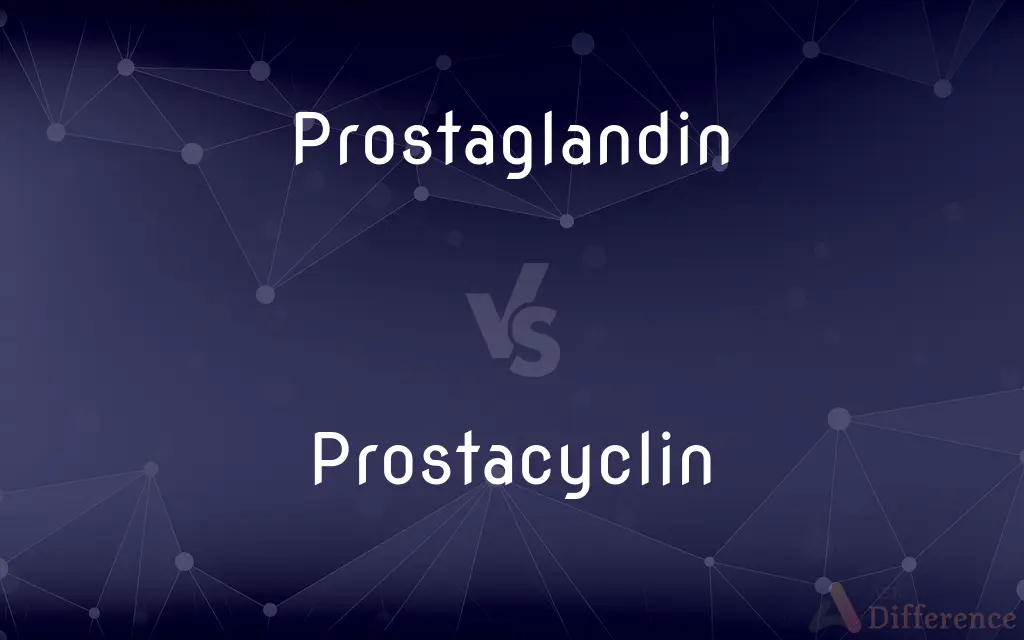Prostaglandin vs. Prostacyclin — What's the Difference?
By Urooj Arif & Fiza Rafique — Updated on March 25, 2024
Prostaglandins are a group of lipid compounds with diverse physiological functions, whereas prostacyclin is a specific type of prostaglandin with potent vasodilatory and antiplatelet effects.

Difference Between Prostaglandin and Prostacyclin
Table of Contents
ADVERTISEMENT
Key Differences
Prostaglandins encompass a broad class of fatty acid derivatives that mediate various physiological processes, including inflammation, pain, fever, and the induction of labor. On the other hand, prostacyclin (PGI2) is a specific prostaglandin that plays a critical role in inhibiting platelet aggregation and vasodilation, primarily affecting cardiovascular health.
While prostaglandins are produced in almost all tissues and organs, exerting wide-ranging effects in the body, prostacyclin is primarily synthesized in the endothelial cells lining the blood vessels. This distinction underscores prostacyclin's specialized function in modulating blood flow and preventing clot formation, whereas prostaglandins have more generalized roles.
Prostaglandins' functions are vast and varied, including roles in the gastrointestinal tract to protect the mucosal lining, in the kidneys to regulate blood flow, and in the reproductive system to facilitate childbirth. Prostacyclin, however, is specifically focused on cardiovascular health, reducing blood pressure and preventing thrombosis.
The synthesis of both prostaglandins and prostacyclin involves the enzyme cyclooxygenase (COX), but the pathways diverge, leading to the production of different compounds within the prostaglandin family. Prostacyclin's synthesis, involving its own unique synthase, highlights its specialized role in the body.
Despite their differences, both prostaglandins and prostacyclin are integral to the body's homeostasis. Inhibitors of their synthesis, such as nonsteroidal anti-inflammatory drugs (NSAIDs), can have wide-ranging effects, from reducing pain and inflammation to increasing the risk of blood clots, illustrating the importance of these compounds in maintaining physiological balance.
ADVERTISEMENT
Comparison Chart
Classification
Broad class of lipid compounds
Specific type of prostaglandin
Primary Functions
Mediate inflammation, pain, fever, and induce labor
Inhibit platelet aggregation, vasodilation
Production Sites
Almost all tissues and organs
Endothelial cells lining the blood vessels
Effects on the Body
Wide-ranging, including gastrointestinal protection, renal blood flow regulation
Reduces blood pressure, prevents thrombosis
Synthesis
Via cyclooxygenase (COX) enzymes
Involves cyclooxygenase and prostacyclin synthase
Importance in Health
Essential for various physiological processes
Critical for cardiovascular health
Clinical Applications
Treatment of various conditions, including arthritis and menstrual pain
Used to treat pulmonary arterial hypertension, prevent clotting in dialysis
Compare with Definitions
Prostaglandin
Affects kidney function and blood flow.
Prostaglandins help maintain adequate kidney blood flow.
Prostacyclin
Synthesized in the endothelial cells of blood vessels.
Prostacyclin production in the endothelium helps prevent thrombosis.
Prostaglandin
Regulates body temperature and fever response.
Prostaglandins in the brain can cause fever as part of the immune response.
Prostacyclin
Used in medical settings to prevent clotting in dialysis procedures.
Prostacyclin analogs are administered during dialysis to prevent blood clots.
Prostaglandin
Lipid compounds that mediate various physiological processes, including inflammation and pain.
Prostaglandins play a role in the pain and swelling of inflammation.
Prostacyclin
Plays a role in the healing process of vascular injuries.
Prostacyclin aids in the repair of damaged blood vessels by inhibiting unwanted clot formation.
Prostaglandin
Protects the gastrointestinal tract's mucosal lining.
Prostaglandins decrease stomach acid and increase mucus production to protect the stomach lining.
Prostacyclin
A prostaglandin that acts as a potent vasodilator and inhibits platelet aggregation.
Prostacyclin is used therapeutically to treat pulmonary arterial hypertension.
Prostaglandin
Involved in the induction of labor by ripening the cervix.
Prostaglandin gels are used to induce labor in pregnant women.
Prostacyclin
Has anti-inflammatory properties.
Prostacyclin can reduce inflammation in blood vessels, contributing to cardiovascular health.
Prostaglandin
The prostaglandins (PG) are a group of physiologically active lipid compounds called eicosanoids having diverse hormone-like effects in animals. Prostaglandins have been found in almost every tissue in humans and other animals.
Prostacyclin
Prostacyclin (also called prostaglandin I2 or PGI2) is a prostaglandin member of the eicosanoid family of lipid molecules. It inhibits platelet activation and is also an effective vasodilator.
Prostaglandin
Any of a group of potent hormonelike substances that are produced in various mammalian tissues, are derived from arachidonic acid, and mediate a wide range of physiological functions, such as control of blood pressure, contraction of smooth muscle, and modulation of inflammation.
Prostacyclin
A prostaglandin produced in the walls of blood vessels that acts as a vasodilator and inhibits platelet aggregation.
Prostaglandin
(biochemistry) Any of a group of naturally occurring lipids derived from the C20 acid prostanoic acid; they have a number of physiological functions and may be considered to be hormones.
Prostacyclin
(organic compound) A prostaglandin produced in the walls of blood vessels; it acts as a vasodilator and inhibits the aggregation of platelets
Prostaglandin
Potent hormone-like substance found in many bodily tissues (and especially in semen); produced in response to trauma and may affect blood pressure and metabolism and smooth muscle activity
Common Curiosities
Where is prostacyclin produced?
Prostacyclin is produced in the endothelial cells lining the blood vessels.
Do prostaglandins have a role in kidney function?
Yes, prostaglandins regulate renal blood flow and contribute to the excretion of sodium and water.
What is prostacyclin's main function?
Prostacyclin primarily acts as a vasodilator and inhibits platelet aggregation, playing a critical role in cardiovascular health.
Can prostaglandins and prostacyclin affect pregnancy?
Yes, prostaglandins can induce labor, while prostacyclin's role during pregnancy is less direct, primarily affecting blood flow.
What impact does prostacyclin have on blood pressure?
Prostacyclin lowers blood pressure by dilating blood vessels and inhibiting platelet aggregation.
How do prostaglandins affect the gastrointestinal tract?
Prostaglandins protect the mucosal lining of the gastrointestinal tract by increasing mucus production and decreasing acid secretion.
Can inhibition of prostaglandin synthesis lead to side effects?
Yes, inhibiting prostaglandin synthesis can lead to gastrointestinal issues, increased blood pressure, and reduced kidney function.
What are prostaglandins?
Prostaglandins are a group of lipid compounds that mediate various physiological functions, including inflammation, pain, and fever.
How are prostaglandins produced in the body?
Prostaglandins are produced through the action of cyclooxygenase enzymes on arachidonic acid, found in cell membranes.
Are there drugs that target prostaglandins and prostacyclin?
Yes, NSAIDs inhibit prostaglandin synthesis, and specific prostacyclin analogs are used to treat conditions like pulmonary arterial hypertension.
What are the therapeutic uses of prostacyclin?
Prostacyclin is used therapeutically to treat pulmonary arterial hypertension and to prevent clotting in dialysis.
How do prostaglandins and prostacyclin differ in their roles in inflammation?
Prostaglandins are directly involved in mediating inflammation and pain, whereas prostacyclin has anti-inflammatory properties and works more specifically within the cardiovascular system.
Share Your Discovery

Previous Comparison
Film vs. Cassette
Next Comparison
Miss vs. MessAuthor Spotlight
Written by
Urooj ArifUrooj is a skilled content writer at Ask Difference, known for her exceptional ability to simplify complex topics into engaging and informative content. With a passion for research and a flair for clear, concise writing, she consistently delivers articles that resonate with our diverse audience.
Co-written by
Fiza RafiqueFiza Rafique is a skilled content writer at AskDifference.com, where she meticulously refines and enhances written pieces. Drawing from her vast editorial expertise, Fiza ensures clarity, accuracy, and precision in every article. Passionate about language, she continually seeks to elevate the quality of content for readers worldwide.














































